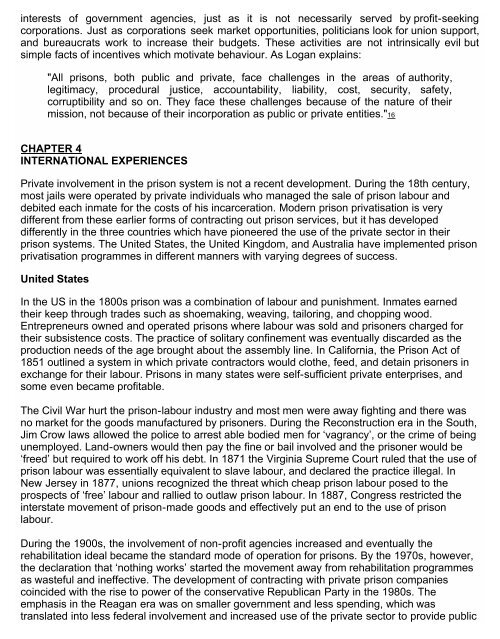prison privatisation in south africa issues, challenges and ...
prison privatisation in south africa issues, challenges and ...
prison privatisation in south africa issues, challenges and ...
You also want an ePaper? Increase the reach of your titles
YUMPU automatically turns print PDFs into web optimized ePapers that Google loves.
<strong>in</strong>terests of government agencies, just as it is not necessarily served by profit-seek<strong>in</strong>g<br />
corporations. Just as corporations seek market opportunities, politicians look for union support,<br />
<strong>and</strong> bureaucrats work to <strong>in</strong>crease their budgets. These activities are not <strong>in</strong>tr<strong>in</strong>sically evil but<br />
simple facts of <strong>in</strong>centives which motivate behaviour. As Logan expla<strong>in</strong>s:<br />
"All <strong>prison</strong>s, both public <strong>and</strong> private, face <strong>challenges</strong> <strong>in</strong> the areas of authority,<br />
legitimacy, procedural justice, accountability, liability, cost, security, safety,<br />
corruptibility <strong>and</strong> so on. They face these <strong>challenges</strong> because of the nature of their<br />
mission, not because of their <strong>in</strong>corporation as public or private entities."16<br />
CHAPTER 4<br />
INTERNATIONAL EXPERIENCES<br />
Private <strong>in</strong>volvement <strong>in</strong> the <strong>prison</strong> system is not a recent development. Dur<strong>in</strong>g the 18th century,<br />
most jails were operated by private <strong>in</strong>dividuals who managed the sale of <strong>prison</strong> labour <strong>and</strong><br />
debited each <strong>in</strong>mate for the costs of his <strong>in</strong>carceration. Modern <strong>prison</strong> <strong>privatisation</strong> is very<br />
different from these earlier forms of contract<strong>in</strong>g out <strong>prison</strong> services, but it has developed<br />
differently <strong>in</strong> the three countries which have pioneered the use of the private sector <strong>in</strong> their<br />
<strong>prison</strong> systems. The United States, the United K<strong>in</strong>gdom, <strong>and</strong> Australia have implemented <strong>prison</strong><br />
<strong>privatisation</strong> programmes <strong>in</strong> different manners with vary<strong>in</strong>g degrees of success.<br />
United States<br />
In the US <strong>in</strong> the 1800s <strong>prison</strong> was a comb<strong>in</strong>ation of labour <strong>and</strong> punishment. Inmates earned<br />
their keep through trades such as shoemak<strong>in</strong>g, weav<strong>in</strong>g, tailor<strong>in</strong>g, <strong>and</strong> chopp<strong>in</strong>g wood.<br />
Entrepreneurs owned <strong>and</strong> operated <strong>prison</strong>s where labour was sold <strong>and</strong> <strong>prison</strong>ers charged for<br />
their subsistence costs. The practice of solitary conf<strong>in</strong>ement was eventually discarded as the<br />
production needs of the age brought about the assembly l<strong>in</strong>e. In California, the Prison Act of<br />
1851 outl<strong>in</strong>ed a system <strong>in</strong> which private contractors would clothe, feed, <strong>and</strong> deta<strong>in</strong> <strong>prison</strong>ers <strong>in</strong><br />
exchange for their labour. Prisons <strong>in</strong> many states were self-sufficient private enterprises, <strong>and</strong><br />
some even became profitable.<br />
The Civil War hurt the <strong>prison</strong>-labour <strong>in</strong>dustry <strong>and</strong> most men were away fight<strong>in</strong>g <strong>and</strong> there was<br />
no market for the goods manufactured by <strong>prison</strong>ers. Dur<strong>in</strong>g the Reconstruction era <strong>in</strong> the South,<br />
Jim Crow laws allowed the police to arrest able bodied men for ‘vagrancy’, or the crime of be<strong>in</strong>g<br />
unemployed. L<strong>and</strong>-owners would then pay the f<strong>in</strong>e or bail <strong>in</strong>volved <strong>and</strong> the <strong>prison</strong>er would be<br />
‘freed’ but required to work off his debt. In 1871 the Virg<strong>in</strong>ia Supreme Court ruled that the use of<br />
<strong>prison</strong> labour was essentially equivalent to slave labour, <strong>and</strong> declared the practice illegal. In<br />
New Jersey <strong>in</strong> 1877, unions recognized the threat which cheap <strong>prison</strong> labour posed to the<br />
prospects of ‘free’ labour <strong>and</strong> rallied to outlaw <strong>prison</strong> labour. In 1887, Congress restricted the<br />
<strong>in</strong>terstate movement of <strong>prison</strong>-made goods <strong>and</strong> effectively put an end to the use of <strong>prison</strong><br />
labour.<br />
Dur<strong>in</strong>g the 1900s, the <strong>in</strong>volvement of non-profit agencies <strong>in</strong>creased <strong>and</strong> eventually the<br />
rehabilitation ideal became the st<strong>and</strong>ard mode of operation for <strong>prison</strong>s. By the 1970s, however,<br />
the declaration that ‘noth<strong>in</strong>g works’ started the movement away from rehabilitation programmes<br />
as wasteful <strong>and</strong> <strong>in</strong>effective. The development of contract<strong>in</strong>g with private <strong>prison</strong> companies<br />
co<strong>in</strong>cided with the rise to power of the conservative Republican Party <strong>in</strong> the 1980s. The<br />
emphasis <strong>in</strong> the Reagan era was on smaller government <strong>and</strong> less spend<strong>in</strong>g, which was<br />
translated <strong>in</strong>to less federal <strong>in</strong>volvement <strong>and</strong> <strong>in</strong>creased use of the private sector to provide public
















